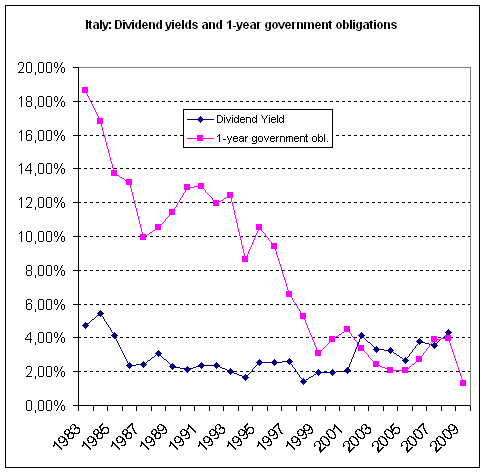Italian stocks below the 1943 and 1960 tops
If you believe that Wall Street is cheap
because the Dow Jones Industrial Average touched the mid-1990s levels,
what about Italy, whose stock market is below the 1943 top, when Benito
Mussolini planned
 to
conquer the world along with his fellow-friend Adolf Hitler?
(Click the chart to enlarge).
to
conquer the world along with his fellow-friend Adolf Hitler?
(Click the chart to enlarge).
The chart in page depicts how deep and how devastating the bear market is in real terms. It is based on data provided by Mediobanca from 1928 to 2006 and on TheEuropeanSide's estimates afterward. The chart is "total return", namely it is inflation adjusted and includes dividends.
As you can see, the March selling climax pushed the Italian stock market well below the top of 1943
- when Italy was on the
verge of the II World War disaster - and well
below the top of 1960 – after a decade of roaring years when Italy
emerged as a good industrial power. According to our calculations, the
March bottom was 20-30% below the tops of 1943 and 1960.

Another long-term historical series is provided by the Comit index,
which goes back to 1972, when it was set equal to 100. Inflation
adjusted, the index was worth 50 at the bottom of March, with a huge and
disappointing long-term loss. If you add dividends, the index was
instead worth about 140, with an annual performance of just less than 1%
per year. Of course, if you include realistic transactional costs and
capital gains, the performance veers once again into a deep negative territory.
Equally important is the role of interest rates and dividend yields. At the March bottom, the value of the
Italian stock market (dividends
included) was roughly at the same
point where it was in 1986. But at the time, interest rates exerted much greater competition to stocks.
One-year government obligations yielded at the time 13.9%, well in excess of the
dividend yield, which was 2.4%.
Now the pendulum has
 swung to the other extreme: one-year government
obligations yield 1.4%, while dividend yields are much greater. Until a
few days ago, Bloomberg consensus estimates indicated a 2009 dividend
yield of some 9%, which is as misleading as anything coming out of the
analyst community during the last few years, but cut it in half and the dividend
yield remains substantial and competitive.
swung to the other extreme: one-year government
obligations yield 1.4%, while dividend yields are much greater. Until a
few days ago, Bloomberg consensus estimates indicated a 2009 dividend
yield of some 9%, which is as misleading as anything coming out of the
analyst community during the last few years, but cut it in half and the dividend
yield remains substantial and competitive.
Talking to the few investors who more or less survived in good shape to
the stock bear market carnage, some are starting to accumulate,
according to what TheEuropeanSide knows. The idea is not to look for the
bottom, but to build up a long-term position over the next few months.
The wildest dream? That during the summer, traditionally a weak season
for stocks, the market suffers a new selling climax, providing a
lifetime opportunity to buy.